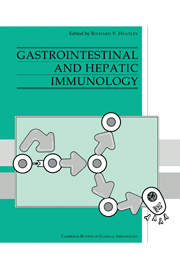Book contents
- Frontmatter
- Contents
- List of contributors
- Preface
- 1 Lymphoid cells and tissues of the gastrointestinal tract
- 2 Lymphocyte migration to the gut mucosa
- 3 Regulating factors affecting gut mucosal defence
- 4 Gastritis
- 5 The immunology of coeliac disease
- 6 Inflammatory bowel disease
- 7 Food intolerance and allergy
- 8 Gastrointestinal and liver involvement in primary immunodeficiency
- 9 Secondary immunodeficiency – the acquired immunodeficiency syndrome (AIDS)
- 10 Intestinal infections
- 11 Lymphomas
- 12 Small bowel transplantation
- 13 Clinical aspects of immunologically mediated intestinal diseases
- 14 Chronic active hepatitis
- 15 Primary biliary cirrhosis
- 16 Immunology and immunopathology of acute viral hepatitis
- 17 Immunology of liver transplantation
- 18 Clinical correlates with hepatic diseases
- Index
10 - Intestinal infections
Published online by Cambridge University Press: 03 February 2010
- Frontmatter
- Contents
- List of contributors
- Preface
- 1 Lymphoid cells and tissues of the gastrointestinal tract
- 2 Lymphocyte migration to the gut mucosa
- 3 Regulating factors affecting gut mucosal defence
- 4 Gastritis
- 5 The immunology of coeliac disease
- 6 Inflammatory bowel disease
- 7 Food intolerance and allergy
- 8 Gastrointestinal and liver involvement in primary immunodeficiency
- 9 Secondary immunodeficiency – the acquired immunodeficiency syndrome (AIDS)
- 10 Intestinal infections
- 11 Lymphomas
- 12 Small bowel transplantation
- 13 Clinical aspects of immunologically mediated intestinal diseases
- 14 Chronic active hepatitis
- 15 Primary biliary cirrhosis
- 16 Immunology and immunopathology of acute viral hepatitis
- 17 Immunology of liver transplantation
- 18 Clinical correlates with hepatic diseases
- Index
Summary
Enteric infection is one of the greatest causes of mortality and morbidity in both human and veterinary species. This is a reflection of the magnitude and diversity of the antigenic challenge to the intestine as well as the ‘complications’ that result from its other physiological roles. That, requires the intestinal tract to have long finger-like villi which not only facilitates the digestion and absorption of nutrients but also provides a large surface area for the interaction with a wide variety of microorganisms and their products.
Important differences exist between the strategies appropriate to the defence from antigen presented via systemic and mucosal routes. Systemic immunity is directed to the active elimination of antigens that have gained entry into host tissues. This is a comparatively rare event and it is appropriate that very powerful mechanisms should be deployed to deal with the intruding material. Such responses may result in collateral damage to the host but by eliminating the provoking material they are self-limiting. In contrast, the immune system of the gut is in constant contact with antigenic material which it is powerless to completely eliminate. Clearly, inflammatory responses under such conditions would be damaging and it is a feature of the gastrointestinal immune system to ‘dampen down’ such responses. While potentially harmful materials and microorganisms remain within the lumen of the intestine, they represent only a minimal threat to the host. It is only when they come into intimate contact with host tissues that they are capable of causing disease.
- Type
- Chapter
- Information
- Gastrointestinal and Hepatic Immunology , pp. 204 - 216Publisher: Cambridge University PressPrint publication year: 1994



